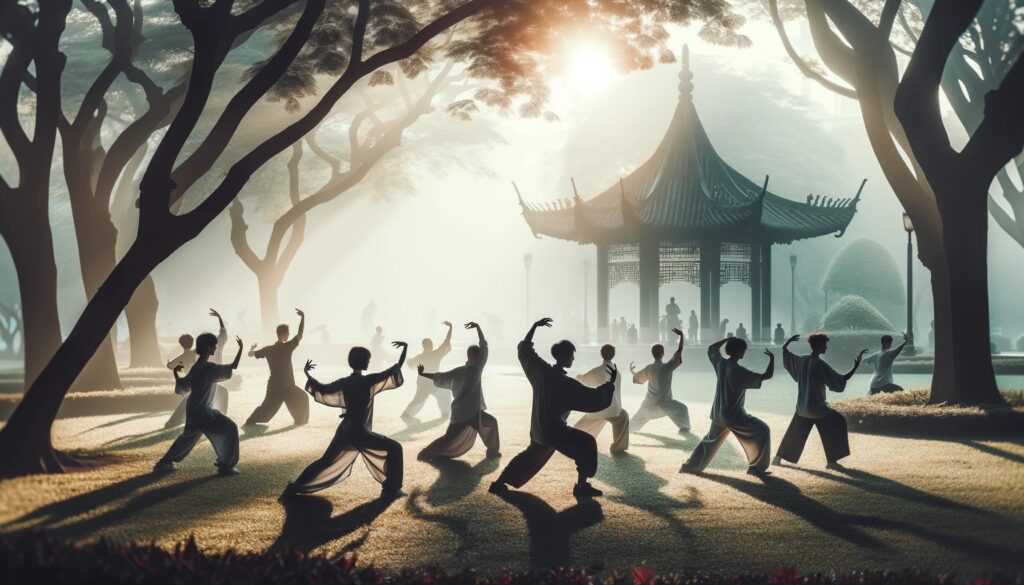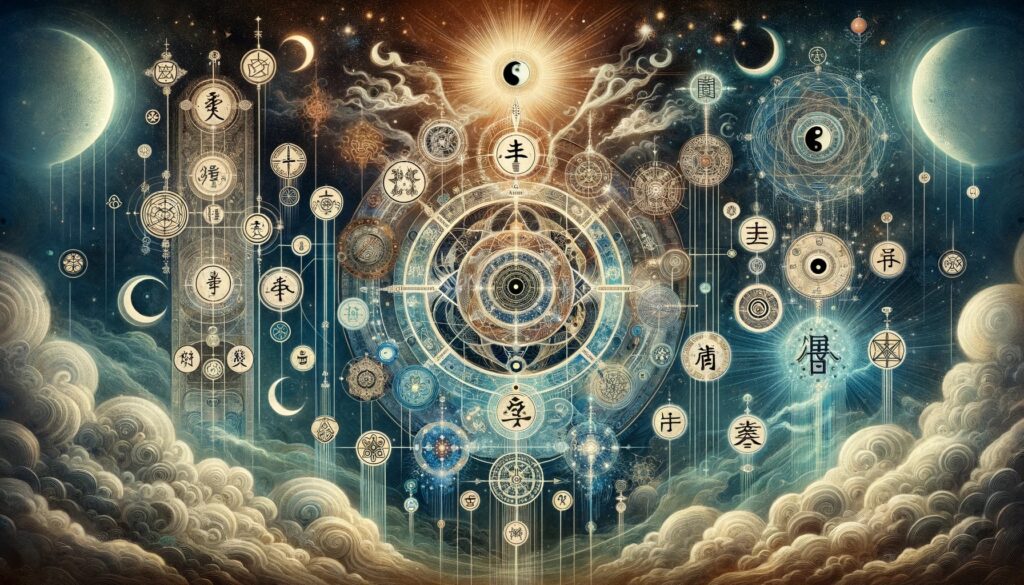What is Taoism (Daoism)?

Imagine a river flowing effortlessly, winding its way through the landscape. It doesn’t fight the current, it doesn’t try to control its path. It simply flows, adapting to whatever comes its way. That, my friend, is the essence of Taoism.
Taoism is more than just a religion; it’s a way of life, a philosophy that encourages us to live in harmony with the natural world and ourselves. At its core lies the concept of the Tao, which translates to “The Way.”
The history of Taoism began a long, long time ago, even before the dinosaurs, just kidding! But really, it started over 2,500 years ago with a wise man named Lao Tzu. He wrote down his thoughts in a book called the “Tao Te Ching,” which is kind of like a super cool guidebook to life.
Taoism, or Daoism, is one of the oldest and most profound philosophical and spiritual traditions from China. It’s all about living in harmony with the Tao, which means “The Way.” But what’s the Tao? Imagine a flowing river—it just goes, naturally and effortlessly, carving its path. Taoism teaches us to live like that, embracing simplicity, spontaneity, and balance.
Taoism isn’t just a set of rules; it’s a way of life. Whether you’re looking for inner peace, better relationships, or just a clearer perspective, Taoism has something to offer.
Basic Taoist Beliefs
Taoism teaches that everything in the universe is connected. There’s this big ol’ thing called the Tao, which is like the invisible force that makes everything tick. Then there’s Yin and Yang – they’re like the best buddies who complement each other. Yin is like the night, quiet and dark, while Yang is like the day, bright and active. Together, they make everything balanced!
The Father of Taoism: Lao Tzu Tao
Lao Tzu, or Laozi, is like the superhero of Taoism. Legend says he was a librarian in the Zhou dynasty, super wise and chill. One day, he decided to leave civilization and ride off on a water buffalo. But before he did, he wrote down his wisdom, and that became the “Tao Te Ching.” It’s like if your granddad wrote down all the best life advice in a book before taking off for the countryside!
Key Figures: Lao Tzu and Zhuangzi
Two legendary figures are often credited with shaping the core of Taoism:
- Lao Tzu: Considered the founder of Taoism, Lao Tzu is believed to have written the Tao Te Ching, a collection of short poems and sayings that offer profound insights into the nature of reality.
- Zhuangzi: A later philosopher, Zhuangzi expanded upon the ideas of Lao Tzu, emphasizing the importance of freedom, spontaneity, and embracing the unknown.
Taoism vs Daoism: What’s in a Name?
Now, you might be wondering, “Why do we say Taoism and Daoism?” Well, it’s all about how you spell things in Chinese! In China, they use characters, not letters, and these characters can be pronounced differently. “Tao” and “Dao” are just different ways to say the same word in English. It’s like saying “color” or “colour,” both are correct, just depends on where you’re from!
Understanding Taoism
The Core Philosophy: The Tao (The Way)
Taoism can be a bit tricky to categorize. It’s not like traditional religions with strict rules and dogmas. It’s more of a gentle guide, a set of principles for living a meaningful life.
Some people see it as a religion, complete with rituals, deities, and temples. Others view it as a philosophy, a way of understanding the world and our place in it.
The Tao is the essence of everything. It’s the source, the path, and the flow. Think of it as the universe’s operating system. Everything in life, from the tiniest atom to the grandest galaxy, follows the Tao.
Taoism and Other Philosophies
Taoism often gets compared to Buddhism because both talk about peace and enlightenment, but they’re different! Taoism focuses more on living in harmony with nature, while Buddhism is about escaping suffering. And with Confucianism? It’s like they’re siblings; one talks about personal harmony, the other about social harmony.
Taoist Principles in Daily Life
Ever heard of “Wu Wei”? It’s one of the coolest Taoist ideas, meaning “non-action” or “effortless action.” It’s not about doing nothing but doing things in a way that feels natural, not forced, like water flowing around rocks. It’s about being chill, going with the flow of life, and not stressing over every little thing.
Key Principles: Wu Wei, Yin and Yang, Qi
Three core principles form the foundation of Taoism:
- Wu Wei: This sounds a bit fancy, but it simply means “effortless action.” It’s about doing things without force, going with the flow instead of fighting against it. Imagine a leaf floating down a stream – it doesn’t resist the current, it simply goes where it’s meant to go. Wu Wei is a really cool concept. It doesn’t mean doing nothing, but rather doing things effortlessly.
- Yin and Yang: This is the concept of duality, the idea that everything in the universe has two opposing forces. Think of day and night, hot and cold, light and dark. These forces aren’t separate, but interconnected and interdependent.
- Qi: This is a vital life force energy that flows through all living things. In Taoism, cultivating and balancing Qi is essential for good health and well-being.
Taoism in Modern Times
Today, Taoism isn’t just in China; its ideas have spread worldwide. People use Taoist principles in business, art, health, and even in video games! It’s all about finding that balance in a world that’s always spinning.
Yin and Yang: The Dance of Opposites
You’ve probably seen the Yin Yang symbol: a black and white circle showing light and dark interwoven. This symbolizes how opposites aren’t enemies; they’re partners. Night needs day, and joy needs sorrow. Taoism teaches us to embrace both sides of life for true harmony.
| Aspect | Yin | Yang |
|---|---|---|
| Energy | Passive | Active |
| Element | Water | Fire |
| Symbolism | Moon, Darkness | Sun, Light |
Taoist Mythology
Taoism has some epic stories, much like fairy tales but with lessons on how to be a good person or how to live forever. There are tales of taoist immortality , people who’ve mastered the Tao so well, they live forever, kind of like superheroes but for peace and wisdom.
Taoist Path to Immortality
What if you could live forever, not just in spirit but in body too? Taoist immortality isn’t about never dying but living a life so in tune with nature that you’re always at peace. There are practices, like special diets, breathing techniques, and alchemy, which sounds like magic but is more about understanding nature’s secrets.
Wu Wei: The Art of Non-Action
Wu Wei sounds like doing nothing, but it’s not laziness! It means acting effortlessly, going with the flow, and not forcing things. Picture a surfer riding a wave—that’s Wu Wei in action.
Tao Te Ching: A Guide to Taoist Wisdom
The Tao Te Ching, written by Lao Tzu, is like Taoism’s Bible. It’s filled with poetic wisdom about living simply and harmoniously. One of its famous lines is: “The journey of a thousand miles begins with a single step.” Profound, right?
The “Tao Te Ching” is Taoism’s main book, and it’s full of little nuggets of wisdom. Imagine it like your favorite storybook, but instead of dragons, there are lessons on how to live simply and peacefully. It’s short, just 81 chapters, each one like a riddle or a poem, teaching you about balance, humility, and living in harmony with nature.
The I Ching: Divination and Guidance
The I Ching is a book of ancient wisdom used for divination. You toss coins or sticks, and the book provides insights. It’s like asking the universe for advice.
History and Development of Taoism
Early Beginnings and Lao Tzu’s Influence
Taoism started around the 6th century BCE with Lao Tzu, a wise old sage who wrote the Tao Te Ching. He taught that simplicity and naturalness are the keys to happiness.
Growth and Integration with Chinese Culture – Taoist Temples and Worship
Over centuries, Taoism blended with Chinese traditions, influencing art, medicine, and even politics. Temples were built, and rituals became part of daily life.
Taoist temples are like peaceful retreats where you can go to meditate, pray, or just chill. Inside, there are statues of deities, which are more like symbols of virtues or aspects of nature. Worship in Taoism is more about connecting with the Tao, often through rituals that celebrate nature, life, and the seasons.
Modern-Day Taoism
Today, Taoism is practiced worldwide. Some people follow it as a religion, while others see it as a philosophy.
Key Beliefs and Practices
Taoist Practices for Well-being
Taoists have some awesome practices to keep you healthy and happy. There’s meditation, which is like taking a quiet time-out where you sit and just be, letting your thoughts float by like clouds. And then there’s Qigong, which is like a dance with your energy. You move slow and steady, helping your body’s energy, or Qi, to flow freely, making you feel like you’re on cloud nine!
The Three Treasures
Compassion, moderation, and humility—these are the core values Taoists live by. They’re like a moral compass guiding us toward kindness and balance.
Taoist Meditation and Mindfulness Techniques
Meditation helps you connect with the Tao. A simple practice? Sit quietly, focus on your breath, and let your thoughts flow like a river.

Qi Energy
Qi (pronounced “chee”) is your life force. Taoists believe in keeping this energy balanced through practices like Tai Chi and Qigong.
Taoist Qigong
Qigong combines movement, breathing, and meditation. It’s great for your health and helps you feel more connected to the world.
Taoist Rituals and Worship
Taoist rituals honor the natural elements and ancestors. Temples are filled with incense, chanting, and offerings.
Taoism and Sexology
Yes, Taoism talks about sex, but it’s not what you think! It’s all about balance, even in love. Taoists believed that by understanding the energy exchange during intimacy, you could live longer, healthier, and happier lives. It’s like learning the dance of life, where every move is about giving and receiving in harmony.
Symbols and Texts in Taoism

The Taoist Symbol
The Yin Yang symbol is probably the most famous, looking like a cool swirl with black and white. It means balance, showing how opposites can come together to make something whole. Taoists love this symbol because it reminds them to keep harmony in their lives. There are other symbols too, like the Bagua, which is like a compass for life, guiding you to balance in different areas.
The Yin Yang symbol isn’t just pretty; it’s deeply meaningful. It reminds us of life’s dualities and the importance of balance.
Sacred Texts
From the Tao Te Ching to the Zhuangzi, Taoist texts are rich with wisdom. They encourage reflection and inspire harmony.
Poetry and Mantras
Taoist poems and mantras help focus the mind and connect with the Tao. Try chanting a simple mantra like “Om” to feel its calming effect.
Taoism is more than philosophy; it’s a way of living harmoniously with yourself and the world around you. Whether through meditation, understanding Yin and Yang, or reading the Tao Te Ching, there’s so much to explore. Start small. Reflect on the Tao in your daily life, and let it guide you to peace and fulfillment.
Taoism is like a secret garden in the vast world of philosophies, where you learn to dance with life rather than fight against it. Whether you’re looking for peace, health, or just a new way to see the world, Taoism has something for you. Embrace the Tao, find your harmony, and let life flow through you like a gentle river.
hgjhgjhg
Table of Contents
FAQs
What is the main belief of Taoism?
Taoism teaches harmony with the Tao, the natural flow of life.
How to practice Taoism?
Start with meditation, embrace simplicity, and live in balance.
Who do Taoists pray to?
Taoists honor deities and natural spirits but focus on harmony with the universe.
Is Taoism atheist?
Taoism is flexible; it can be spiritual or philosophical.
What are the three main beliefs of Taoism?
Compassion, moderation, and humility.
Is Taoism a Buddhist?
No, Taoism and Buddhism are distinct. While they share some similarities like meditation, their core philosophies and practices are different.
How to Become a Taoist
Becoming a Taoist isn’t about joining a club but living by its principles. You can start by reading the “Tao Te Ching,” practicing meditation, or even just trying to see the beauty in everyday life. Find a community if you can, but remember, Taoism is about your journey, your way.
Sources that offer deeper dives into the topics discussed:



